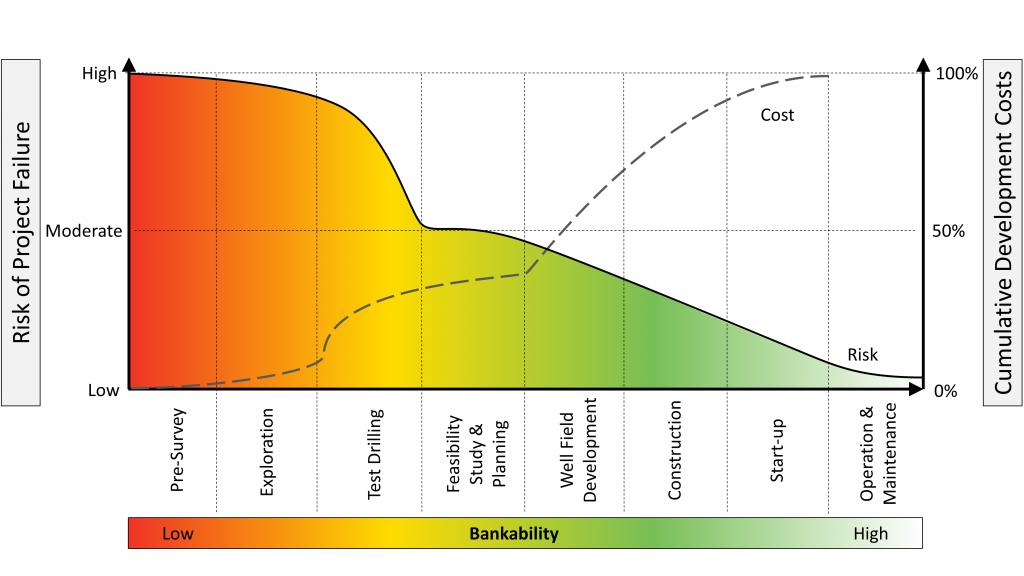Electricity is produced from geothermal energy in many countries. The United States has the largest fleet of geothermal power plants with a total installed capacity of 3,812 MW. In Canada, we have extensive geothermal resources but no power plants. A key reason for this lack of development is resource uncertainty and the associated investment risk.
The best geothermal resources are located in Western Canada. Regions in British Columbia, Alberta, the Yukon and Northwest Territories have relatively shallow reservoirs at sufficient temperatures for geothermal electricity production. The sub-surface temperatures in prairie and eastern provinces are not high enough for electricity production using conventional geothermal technology.
In British Columbia, there are numerous potential development locations. A 2015 study, commissioned by Geoscience BC, highlights 11 prospective sites with a total installed capacity of 634 MW. This is equivalent to 6 % of BC’s peak load and 8 % of annual electricity demand, assuming a 90% annual capacity factor. Note that the 634 MW capacity is a “P50” estimate, which means that there is a 50% chance that the total installed capacity of these 11 sites will be less (or greater) than 643 MW.
The Geoscience BC report capacity as a P50 value due to the significant uncertainty in the geologic conditions of the geothermal reservoirs and in the associated ability to generate power. The sustainable power generation capacity of a geothermal reservoir depends upon its temperature, depth, volume and hydraulic conductivity. The magnitude of these parameters is uncertain and, hence, estimates of generation capacity are also uncertain.
Resource uncertainty can be reduced by drilling costly exploration and confirmation wells. Slim-hole exploration wells can narrow the probable range of some reservoir parameters but full-size confirmation wells are needed to verify sustainable flow rates and temperatures. Exploration wells typically cost approximately $1M and many of these wells may be required. Confirmation wells typically cost $4 to $6M. For comparison, a wind resource measurement campaign typically costs approximately $300,000; a fraction of the cost of drilling a single geothermal exploration well. The consequence is that up to 50% of the total development cost of a geothermal site must be incurred before the value of the resources is determined, as shown in the figure below.

Risk of failure vs. progression of costs of developing a geothermal power plant (Adapted from: M. Gehringer, V. Loksha. Geothermal Handbook: planning and financing power generation. Energy Sector Management Assistance Program: Technical Report 002/12. The International Bank for Reconstruction. The World Bank Group. 2012.)
As with all capital intensive projects, financing is typically not available until the risk of failure is relatively low. However, as noted, low levels of geothermal risk can only be achieved by reducing resource uncertainty, and this can only be achieved by drilling wells which require significant financing. It’s a bit of a Catch 22.
Countries with active geothermal energy industries have established policy support to make financing geothermal energy projects attractive; through reducing the financial risk of resource confirmation and/or by improving post-development profitability. Iceland successfully spurred its geothermal energy industry by reimbursing up to 80 % of the drilling costs for unsuccessful wells. In the United States, federal development grants and loans and state-specific incentives reduce the financial risk of resource confirmation. Additionally, if development proceeds, revenue from geothermal electricity sales is supplemented by US federal corporate tax credits. Other countries, Germany and Kenya for example, have a relatively high guaranteed feed-in-price for 20 years.
In Canada, policy support specific to geothermal energy does not exist. In BC, the Standing Offer Program (SOP) enables developers to sell up to 15 MW of electricity from renewable sources at approximately 110 $/MWh*. This program has successfully incented the development of run-of-river, wind, biomass, biogas, and solar projects. However, Geoscience BC estimates that cost of geothermal energy at all of the 11 prospective sites noted above will exceed the SOP price. These projected costs include transmission costs and range from 117 $/MWh at high-temperature volcanic sites (>150 °C – Meager Creek/Pebble Creek) up to 398 $/MWh at medium-temperature sites in northeastern BC. Furthermore, all but one of these sites have P50 capacities above 15 MW upper limit.
So, why aren’t we using geothermal energy in Canada? As presented here, there are several key reasons: (1) There is significant uncertainty in the true scale of our geothermal resources; (2) Financing geothermal requires confirmation of the resource to reduce this uncertainty, but resource confirmation requires financing – hence, the Catch 22; (3) The projected cost of energy produced from geothermal sources is relatively high and; (4) Existing renewable energy support mechanisms are not sufficient to overcome these barriers. Of course this discussion begs the next question. Should we develop our geothermal resources? This is a much bigger question.
The 2060 project is helping to inform this discussion. A favourability mapping exercise and economic assessment of geothermal resources in Northeastern BC is underway. Results are currently under review and scheduled for public release in early 2018.
*when the time-dependant price is averaged over a year
by: Kevin Palmer-Wilson